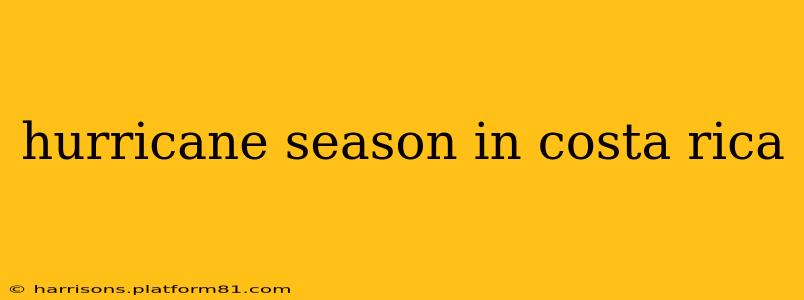Costa Rica, with its stunning beaches and lush rainforests, is a popular tourist destination year-round. However, understanding the country's hurricane season is crucial for planning a safe and enjoyable trip. This comprehensive guide will delve into the specifics of hurricane season in Costa Rica, offering valuable insights for travelers and residents alike.
What is Hurricane Season in Costa Rica?
Officially, hurricane season in Costa Rica runs from June 1st to November 30th. However, the likelihood of experiencing a direct hurricane impact varies significantly across these months. While the peak season generally falls between August and October, it's crucial to remember that tropical storms and heavy rainfall can occur outside these dates. Even if a hurricane doesn't directly hit, the outer bands can still bring significant rain and wind.
What are the most common areas affected by hurricanes in Costa Rica?
Costa Rica's Caribbean coast is significantly more vulnerable to hurricanes than the Pacific coast. The Caribbean side faces the Atlantic Ocean, where hurricanes are more common. Areas such as Puerto Limón and the surrounding towns are at a higher risk. The Pacific coast experiences less frequent direct impacts, although heavy rains and strong winds associated with tropical storms can still occur.
How often do hurricanes hit Costa Rica?
Direct hurricane strikes on Costa Rica are relatively infrequent. The country is often on the periphery of major hurricane paths, meaning it might experience strong winds and heavy rainfall from a passing storm but not a direct hit. However, the impact of even indirect hits can be substantial, causing flooding, landslides, and power outages.
What should I do if a hurricane is approaching Costa Rica?
If you're in Costa Rica when a hurricane is approaching, heed official warnings issued by the National Meteorological Institute (IMN). This includes:
- Stay informed: Monitor weather reports regularly through local news and official government channels.
- Follow evacuation orders: If an evacuation order is issued, comply immediately.
- Secure your belongings: Protect your property by securing loose objects and boarding up windows.
- Stock up on essentials: Gather supplies such as water, non-perishable food, flashlights, batteries, and a first-aid kit.
- Find safe shelter: If you can't evacuate, find a sturdy building away from windows and doors.
What is the difference between a tropical storm and a hurricane?
A tropical storm has sustained winds between 39 and 73 mph (63 and 118 km/h). A hurricane is a more intense tropical storm with sustained winds of 74 mph (119 km/h) or higher. Both can bring significant rainfall and cause damage, but hurricanes pose a far greater threat.
Are there specific travel insurance considerations during hurricane season?
Yes. Purchasing comprehensive travel insurance that covers hurricane-related disruptions is highly recommended during hurricane season. This can provide protection against flight cancellations, accommodation changes, and other unforeseen circumstances caused by severe weather.
Is it safe to travel to Costa Rica during hurricane season?
While the risk of a direct hurricane hit is relatively low, it's crucial to acknowledge the possibility of heavy rainfall, strong winds, and associated disruptions. Many parts of Costa Rica remain accessible and enjoyable even during hurricane season. However, careful planning, monitoring weather forecasts, and purchasing appropriate travel insurance are vital.
Conclusion:
Costa Rica's hurricane season presents a range of potential impacts, from minor inconveniences to significant disruptions. By understanding these risks and following the advice outlined above, travelers and residents can minimize potential problems and enjoy the beauty of Costa Rica, even during the hurricane season. Remember, preparedness is key to a safe and enjoyable experience.
